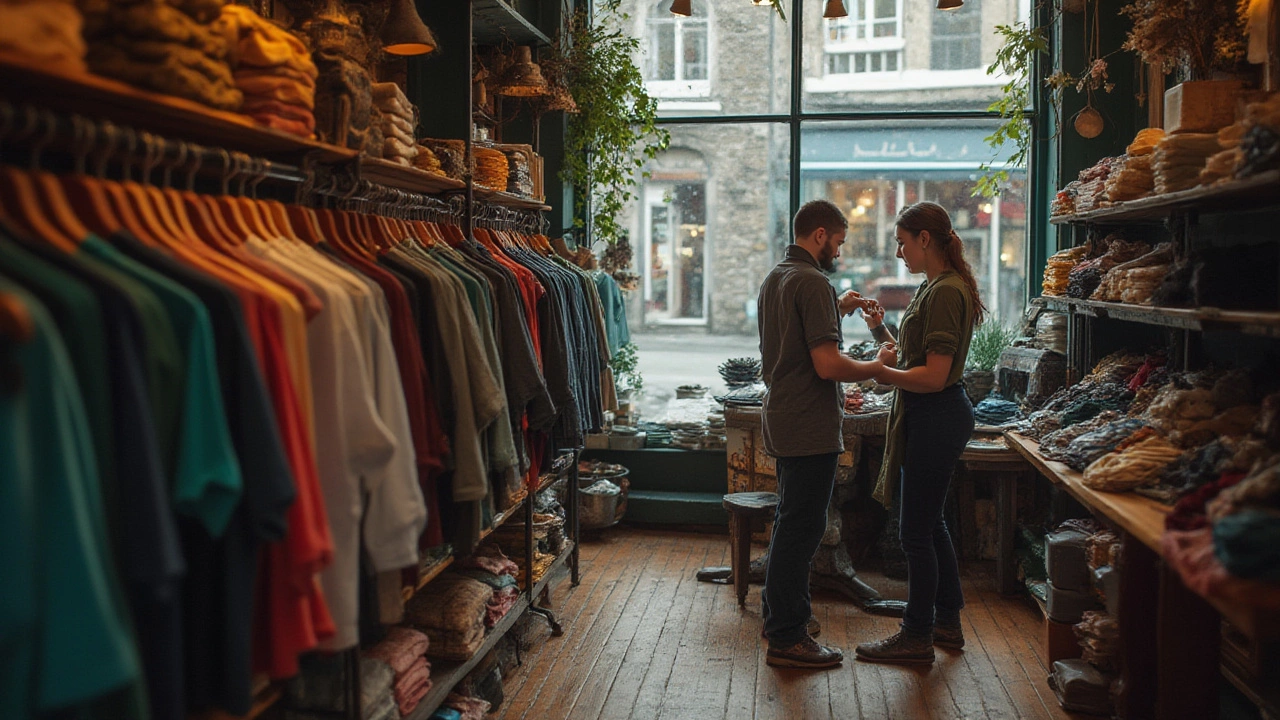You walk into Penneys on Henry Street or maybe flick through a rack at Avoca in Belfast, and there it is again: the wall of endless t-shirts. Some are €7, some cost three times that. Two washes later, cheap ones turn twisty and those expensive ones don’t always feel so fancy either. Picking a good quality t-shirt can feel like winning the lottery – especially in Ireland where soggy bus stops, wild wind, and surprise heatwaves can all make or break your style game. Let’s cut through the confusion together and make sure your next t-shirt is the kind you actually want to wear—rain, shine, or a session in Coppers.
The Fabric Test: What Works in Ireland’s Weather
With Irish weather being about as predictable as a DART timetable, fabric matters more than you’d think. Cotton comes up first for most people—and for good reason. Irish climate means you’ll want something breathable but not flimsy; think tightly-woven cotton rather than that thin, see-through stuff that shrinks by lunchtime. Organic cotton crops up more in shops like Wild Atlantic Weaves or The Kind on Fade Street. It’s usually softer, with a tighter knit, and holds up better to constant drizzle and the odd sun burst. For versatility, a cotton-modal blend stands up well on muggy Dublin days and won’t cling during Galway’s gusty afternoons by the Corrib.
Ever felt a t-shirt in Savida at Dunnes and thought it had a weird sheen? That’s usually polyester sneaking in—which is handy for sportswear but not as breathable. If you’re planning to layer up (because, let’s face it, June doesn’t always mean summer here), check the label for at least 90% natural fibres. Linen is a surprise winner—yes, it wrinkles—but it’s airy and has that easy “off to brunch in Clontarf” look.
For the active crowd, bamboo blends are a smart find. Bamboo is popping up in Irish eco-brands and feels silky, resists odours (a.k.a. for your next Dash in the Dark run), and dries quickly if you get caught in a Kerry shower. Trust your hands: Quality cotton bounces back if you tug it gently, doesn’t pill when scratched, and feels sturdy, not stiff.
Local Shops vs. Fast Fashion: Spotting Genuine Irish Quality
Bargain bins in high-street chains like New Look or H&M are grand for a quick fix, but you’ll spot the difference between them and shops championing Irish design. Folkster, Fresh Cuts, and Irish Design Shop in Dublin give you tees that last, with actual attention to how seams are stitched and whether the collar warps after a wash. Look out for tees labelled “Made in Ireland”—while they’re rare, you’ll find the likes of IrelandsEye Knitwear branching into tees crafted right here and designed for our climate.
Events like Dublin Flea Market and Creative Fair at Cork’s Marina Market are gold mines for one-off, locally produced tees. You can chat to the makers, ask what materials they use, and even get a peek at their ethos. Irish consumers are greener these days, with over half preferring sustainable options; expect more organic cottons, recycled fibres, and low-impact dyes. If you want something built to last, support these smaller brands. Keep receipts and check for visible warranty policies; good Irish brands usually replace or repair items with manufacturing faults—much more than the global chains offer.
Facebook Marketplace and Depop are blowing up for Irish fashion. You’ll find vintage tees from gigs at 3Arena or throwback GAA shirts that still look decent. Read the reviews, ask about wear and tear, and go for brands that honestly describe their condition. Beware of fakes, especially logos and labels trying to look like Irish surf brands but made abroad. If you want to spot authentic Irish, check that tags have addresses in Ireland or a company registration you can look up online.
Fit and Feel: What Suits Irish Lifestyles
The fit is everything—especially here, where a t-shirt might be your only layer on a warm day out at Phoenix Park or hidden under jumpers at the Cliffs of Moher in September. Don’t trust hanger illusions; try the tee on. Shoulders should line up with yours, not droop, and the length should cover your waistband—no riding up when you run for the bus.
Slim fit, regular, oversized—each suits different occasions. Regular or slightly loose fits work best if you’re out for a pint in Cork or running errands in Limerick, thanks to room for layering. Avoid overly tight collars if you hate that stretch-mark look after a few wears. Irish brands like Human Collective and GROWN Clothing nail the balance with gender-neutral cuts that adapt for all shapes and sizes. If you want to shop online, check brands with good returns—like Brown Thomas or Siopaella—so you’re not stuck with an odd-fitting mistake.
Neck style is personal, but for Irish weather, a standard crew neck keeps the wind out better than a v-neck. If you want breathability, scoop necks or loose crews stop sweat patches at summer festivals (hello, Electric Picnic). Short sleeves are classic, but rolled or capped sleeves add style points without looking like you’re trying too hard. Always check the inside seams and hem stitching: Double-stitching means less twisting, even after heavy spins in hard Irish water—your future self will thank you.

Style, Patterns, and Irish Identity: Stand Out—or Blend In
Irish style loves understatement. Plain colours—think muted greens, navy, and marl grey—work almost everywhere from Trinity quad to a Saturday in Clonakilty. But don’t be shy about a slogan tee or subtle print if it speaks to your story. Retro GAA designs, Guinness graphics, and tees repping county pride are conversation starters across generations. Homegrown brands like Bitter Rocc or Fiú bring out limited runs of tees inspired by Irish music, geography, or classic sayings. Their small-batch releases mean you’re less likely to match someone at the bus stop on O’Connell Street.
Pocket tees have seen a comeback, perfect for stashing small change or festival wristbands. Dip dye and tie-dye got a fresh Irish spin with seaweed designs from brands along the Atlantic Way. If you want something bold, shops in Temple Bar or St. Patrick’s Street carry unique tees from new-to-market designers, just keep an eye that prints are well-finished—no cracked logos after one wash.
For layering, stick with neutral shades. These work under a shirt, jersey, or light blazer for pub nights or office Fridays. Want to match Ireland’s natural tones? Colours that echo our landscape—like soft moss, wild heather, and deep sky blue—go with most Irish wardrobes. You’ll find plenty of Irish influencers, like Roz Purcell and James Kavanagh, showing how to style the humble tee with both trainers and boots.
Caring for Your Tee: Make it Last on the Emerald Isle
So, you’ve scored the perfect t-shirt. But how do you stop it turning into a rag after two months in Irish weather? Water here is limescale-heavy (especially in Dublin and Galway), so gentle washes matter. Flip tees inside out, use a mild detergent like Ecover (easy to find in health shops across Ireland), and avoid harsh softeners. Most quality Irish t-shirts don’t need hot washes; cold is best for shape and colour.
Always air dry—our breezes do the work, and tumble dryers eat up cotton fibres faster than a rainy marathon through Stephen’s Green. If you’re in a rush, low-heat only. Iron on the inside, especially with printed tees, to dodge cracked graphics. Don’t overload your machine; give each tee space. A tip direct from Avoca’s staff: stretching when wet is a no-go. Shape while damp, smooth seams, then hang or lay flat.
If you see piling already, try a gentle fabric shaver—widely available from Argos or Elvery’s. Stains? Irish grass can be brutal on whites, so always dab, don’t rub. Use a little baking soda paste if you’re out of stain remover. Buy better, wash smarter, and you’ll see favourite tees last from the Cork Jazz Festival right through to Bloomsday and back again.
Spotting Quality T-Shirts: How to Avoid the Duds
You’re shopping for the good quality t-shirt that feels like magic every time you slip it on. Here’s how to spot a winner. First, weight matters. Light and soft isn’t always flimsy—check the ‘gsm’ or grams per square metre if you can. Most Irish high street chains don’t list it, but specialist stores and local makers (like Hazel Mountain or All Things Fiona Lily) often share fabric weight. Sweet spot? 160-200 gsm for everyday, 220+ for heavyweight winter wear.
Smell the fabric if you dare—synthetics sometimes carry a plasticky scent, especially in newly dyed fast fashion. Trust your sense of touch; a quality tee feels smooth but not slippy, and never scratchy. Neckbands should be stretchy but not loose; the band should ‘snap back’ to shape when you let it go. Check arm hems—if threads are loose or you see skipped stitches, move on. Good tees have tight, even seams and no dangling threads.
Brand reputation plays a big role in Ireland, where word gets around fast if a product disappoints. Ask mates or search Irish Reddit threads for up-to-date opinions. At markets, never be shy to ask a stallholder where their tees come from and if you can try one on. Shops like Tola Vintage or Lucy’s Lounge in Dublin will let you touch and check before buying. Avoid tees with aggressive chemical dyes or overwhelming acid brights. These often wash out fast, especially in soft rural Irish water.
Look for additions like anti-pill treatment, reinforced shoulder seams, and ‘preshrunk’ labelled on the tag. Local brands reward loyal customers with info—follow their social media for washing hacks, how-to guides, and sometimes even free lifetime repairs. Good t-shirts feel like home, even after three years of Irish weather. So when you find that unicorn tee—buy a few, you’ll thank yourself when festival season rolls around again!
